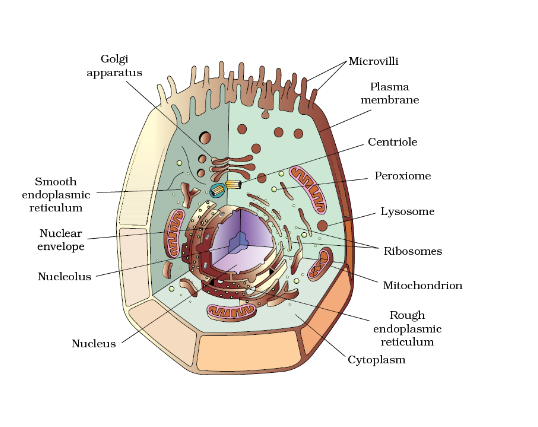Table of Contents
An animal cell, categorized as a eukaryotic cell, is distinguished by the absence of a cell wall and the presence of a fully enclosed nucleus, along with various other organelles within its membrane.
Animal Cell Structure: Animal cells are a fundamental unit of life within the kingdom Animalia. They are eukaryotic cells, characterized by their unique features, including a plasma membrane, a membrane-bound nucleus, and various organelles. Unlike plant and fungal cells, animal cells lack a cell wall, a feature that was lost during the evolutionary process.
In this article, we will explore the characteristics and components of animal cells. Additionally, animal cells draw comparisons to plant cell structures, highlighting the unique characteristics of animal cells.
Animal Cell Diagram with its Structure
When examining the composition of an animal cell, it becomes apparent that animal cells are typically smaller in size compared to plant cells. Their irregular shape is a distinct feature resulting from the lack of cell walls. Both plants and animals originate from eukaryotic cells and share certain organelles.
While plant cells are also eukaryotic, the presence of chloroplasts distinguishes them from animal cells.

Animal Cell Structure And Function
Animal cells are typically smaller in size compared to plant cells and have an irregular shape, mainly because they lack a cell wall. However, despite these differences, animal cells and plant cells have common cellular organelles since they both originated from eukaryotic cells.
The essential organelles found in a typical animal cell include:
-
Plasma Membrane
The plasma membrane, also known as the cell membrane, forms the outer boundary of animal cells. It consists of a phospholipid bilayer embedded with proteins and serves as a selective barrier, regulating the movement of substances in and out of the cell. The plasma membrane is crucial for maintaining cell integrity and facilitating communication with the external environment.
-
Nucleus
Animal cells contain a membrane-bound nucleus, which houses the cell’s genetic material in the form of chromosomes. The nucleus plays a vital role in regulating gene expression, DNA replication, and the synthesis of RNA. It is surrounded by a nuclear envelope, which separates the nucleus from the cytoplasm and contains nuclear pores that facilitate the exchange of materials.
-
Cytoplasm
The cytoplasm is the gel-like substance that fills the cell between the plasma membrane and the nucleus. It consists of a mixture of water, salts, and various cellular components. Within the cytoplasm, numerous metabolic reactions occur, including protein synthesis, energy production, and cellular transport processes.
-
Organelles
Animal cells contain various organelles, each with specific functions:
- Mitochondria: Mitochondria are often referred to as the “powerhouses” of the cell since they generate energy through cellular respiration. They convert nutrients into adenosine triphosphate (ATP), the cell’s main energy currency.
- Endoplasmic Reticulum (ER): The ER is a network of membranous tubules and sacs involved in protein synthesis, lipid metabolism, and the detoxification of harmful substances.
- Golgi Apparatus: The Golgi apparatus modifies, sorts, and packages proteins and lipids for transport to their specific destinations within or outside the cell.
- Lysosomes: Lysosomes are membrane-bound vesicles containing digestive enzymes that break down waste materials, cellular debris, and engulfed pathogens.
- Peroxisomes: Peroxisomes participate in various metabolic reactions, including the breakdown of fatty acids and the detoxification of harmful substances.
- Cytoskeleton: The cytoskeleton is a network of protein filaments that provides structural support, facilitates cell movement, and aids in cell division.
Animal Cell Types: Specialized Cells and Their Functions
Animal cells come in various types, each designed to perform specific functions within the organism. Understanding the different types of animal cells is crucial for comprehending the diversity of cellular structures and their contributions to overall organismal function.
- Skin Cells: The skin is the largest organ of the body and consists of various specialized cell types, including Melanocytes, Keratinocytes, Langerhans Cells etc
- Muscle Cells: Muscle cells are specialized for contraction and movement. There are different types of muscle cells, including Myocytes, Myosatellite Cells, Tendon Cells etc
- Blood Cells: Blood cells are essential for transporting oxygen, fighting infections, and maintaining overall homeostasis. Some key types of blood cells include Leukocytes, Erythrocytes, Platelets,
- Nerve Cells: Nerve cells, also called neurons, are specialized for transmitting electrical signals and facilitating communication within the nervous system. Some important types of nerve cells include Schwann Cells, Glial Cells, Fat Cells.
Conclusion
Animal cells, as eukaryotic cells, possess distinct characteristics and components that enable them to carry out essential biological functions. The plasma membrane, nucleus, cytoplasm, and animal cell organelles work together harmoniously to maintain cellular integrity, regulate metabolic processes, and facilitate communication within the organism. Understanding the animal cell function and structure is crucial for comprehending the complexity of living organisms.

FAQs on Animal Cell Structure
What is an animal cell?
An animal cell is a type of cell found specifically in animal tissues. It is characterized by the absence of a cell wall, with animal cell organelles enclosed within the cell membrane.
Which organelle contains the genetic material of the cell?
The nucleus contains the genetic material of the cell, including DNA organized into chromosomes.
What organelle is responsible for the generation of energy for cellular activities?
Mitochondria are responsible for generating energy through cellular respiration, producing ATP for cellular activities.
What is the name of the double-layered membrane that surrounds the nucleus?
The double-layered membrane surrounding the nucleus is called the nuclear envelope.
What is the role of lysosomes?
Lysosomes play a role in digestion, excretion, and cell renewal processes. They contain enzymes that break down macromolecules and cellular waste materials.









